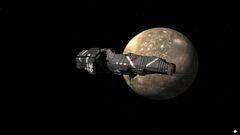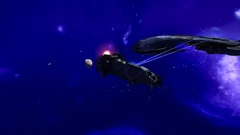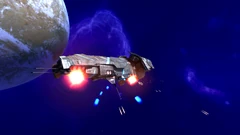| This fanfiction article, Hyperion-class destroyer, was written by Sev40. Please do not edit this fiction without the writer's permission. |
| This article, Hyperion-class destroyer, was written by Sev40, but may be used freely by other users even without the author's explicit permission. |
| Hyperion-class destroyer | |
|---|---|

| |
| Class Overview | |
|
BUILDERS |
|
|
OPERATORS |
|
|
CLASS BEFORE |
|
|
IN SERVICE |
2546-present |
| Technical Specifications | |
|
TYPE |
|
|
LENGTH |
398 metres |
|
MASS |
1.41 million metric tons |
|
HULL |
1.25-2 metres of Titanium-A1 battleplate |
|
NAVIGATION SYSTEMS |
UNA-uplinked navigation computer |
|
COUNTERMEASURES |
VANGUARD bridge defence system |
|
ARMAMENT |
|
|
COMPLEMENT |
175 sailors |
| Additional Information | |
|
ERA |
|
|
ROLE |
|
| [Source] | |
- "They're the perfect wolfpack ship - fast enough to keep up with scouting corvettes, modular enough to quickly respond to new threats, and deadly enough to overwhelm any enemy they encounter."
- ―Anonymous UNSC crewman.
The Hyperion-class destroyer (hull classification symbol: DD), colloquially dubbed the pocket destroyer by sailors because of its small size, is a next-generation destroyer utilised by the UNSC Navy in the last decade of the Human-Covenant War. Introduced as a cheaper, more effective warship to relieve the UNSC's aging fleet, the Hyperion is a response to the combat data of its' immediate predecessor, the Halberd-class destroyer. While it is true they are not as durable and some of the endurance displayed by previous destroyers, they make up for this with a modular design that allows them to be quickly refitted to counter new threats, a far smaller target profile, more advanced defensive subsystems, enhanced armaments and the ability to be built at any shipyard rated at building frigates.
Key to the Hyperion's success lies mainly in two fields; its size and larger-than-average fusion reactors. By shedding off some of the armour and redundant superstructure of its predecessor, the Hyperion is able to reduce its weight by nearly four hundred thousand tons and correspondingly reduce its target profile. This already increases its speed by a large margin, which is further enhanced by three massive fusion reactors. These allow it to support not only more powerful propulsion systems, but also allow it to utilise more MACs than previously thought possible. These two strengths ensured that a battlegroup of Hyperions could evade more shots and dish out more damage at range than even larger ships.
First commissioned in 2541, the Hyperion would see some early action in 2546, yet issues with its streamlined supports and power output would limit production until after 2553. Constructed alongside other 'frankenships' - warships which are hastily outfitted with any available starship component - they would serve in only a number of campaigns centered around human colonies due to their small numbers. However, continued development would see the Hyperion reach and surpass all areas of the Halberd. Even as they took over from the most elderly ships in the UNSC fleet, they would only exceed the annual production of their predecessor by 2556.
History[]
Background[]
When the Human-Covenant War erupted first, the entirety of the UNSC was held in a state of shock. After centuries of searching, humanity's discovery that the first advanced sapient life they encountered was determined to see them destroyed put them on the back foot. This was best cemented during the first decade of the war; disregarding Vice Admiral Cole's campaigns, the took an uprecedented stretch of losses which forced them only to make stands at key colonies. The Covenant's ingenious invasion strategy, which often resulted in a number of colonies and habitats being attacked at the same time, was the main reason for this. However, their sheer technological superiority and unfamiliarity of their ships meant that once engaged there was very little chance for the UNSC to finish the battle without taking severe losses. These engagements meant that many fleeing ships would be picked off long before they arrived at their designated rally point, with even entire fleets being lost when they underestimated Covenant fleet numbers.
Eventually, within the decade the UNSC admiralty was forced to accept that they were facing a threat to their very existence. While all other branches of the UNSC began to address ways aimed at increasing their effectiveness, the UNSC Navy was seen as being extremely passive when adopting new technologies and armaments. Either out of habit or continual downplay of the Covenant threat, the Navy continued their doctrine of quantity over quality, with only their tactics and strategies actively changing. This encouraged their suppliers to make incremental improvements with some fleet-wide refits, or in the case of SinoViet's products even cutting out entire subsystems to deliver them sooner. This is in spite of studies consistently arguing that all existing ship classes, especially those which predate the Insurrection such as the Charon-class light frigate, required a minimum of three ships to beat their Covenant equivalents. The Admiralty's preference not to adopt more expensive replacements meant that the bulk of the fleet was made up of the exact same ships throughout the entire war.
Not all of this was the Admiralty's fault, however. Despite the risk to their very existence, many shipbuilding corporations were reluctant to offer replacements for their very successful products, believing that in time the Navy would learn how to best deploy their ships to offset their ineffectiveness. As this became less and less likely, they took to developing expensive starship designs, always drastically marking up their cost to keep existing classes of warships attractive in spite of the ever-worsening expected outcome of the war. Reports about how badly their ships are to their Covenant equivalents were carefully reworded to make them seem more reasonable; for example, Halberd-class destroyers were compared to Covenant frigates. Despite these measures, shareholders continued to grow less confident in the major suppliers' ability to offer a means to better protect them even as their revenue slowly grew, flocking to smaller companies eager to offer better alternatives. With the reality of smaller private entities wielding a disproportionate amount of influence on the company's decision-making making small steps closer, some of these companies began to seriously work on the development of successors - in the case of SinoViet, the pressure reached this point by at least 2535, when the design phase of the Hyperion-class began.
Development[]
- "I made it explicitly clear to our contractors that while the new destroyer would be built using much more advanced technologies, the price would need to be equivalent to its predecessor. This isn't lobbying for some contract anymore; we're in a battle for survival."
- ―Commander Richard Nixon
With extensive studies on the feasibility of the Halberd-class already conducted by the Office of Naval Intelligence, the development of the new frigate was intended to mirror the same strengths of the proceeding ship. The Halberd, despite itself being an intelligently-built, well-balanced warship, was supposed to be modular enough to allow it to be expanded into an entire platform which SinoViet would build off of for later classes. This design brief would be largely copied for use in the new destroyer, despite attempts from executives to 'modernise' it - the necessity of the crew justified because of the ease ONI can spin extraordinary circumstances into propaganda, and more hyper-advanced components would prevent the Navy from adopting it due to the cost. This latter reasoning would add a clause to prevent the new destroyer from exceeding 133% of the Halberd's original cost.
Layout[]
Specifications[]
Propulsion and Powerplant[]
Armament[]
Armour and Superstructural Supports[]
Complement[]
Sensors and Countermeasures[]
Role and Tactics[]
As a modernised adaptation of the Halberd-class destroyer, the Hyperion-class destroyer inherits its intended use as a conventional ship of the line, supplementing the capital ships with its diverse range of weapons, protecting the carriers, and providing overwatch for the rest of its unit - a role they share with frigates.
Weaknesses and Counter-tactics[]
Ships of the Line[]
| Name | Hull Classification Symbol | Commissioned | Destroyed | Notes |
| Lead ship of the class. | ||||
| Daiichi Kimura's second warship he served on, participated in the Battle for Alluvion. |
Trivia[]
- This article sources most of its pictures from Halo Homefront's Thanatos-class destroyer, their re-imagining of the Halberd-class destroyer. The original concept was drawn by Kwibl.
Gallery[]
Notes[]
- ↑ The Hyperion-class destroyer was originally slated to be armed with the M70 Sentry autocannons, but the loss of WST's research and development laboratory on Kholo brought an end to the program. As a result, early destroyers were armed with the placeholder M66 autocannons until their replacement was released.







